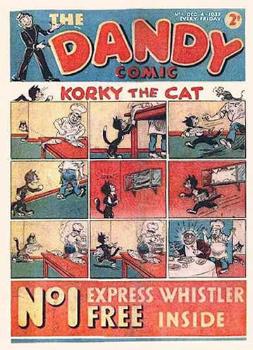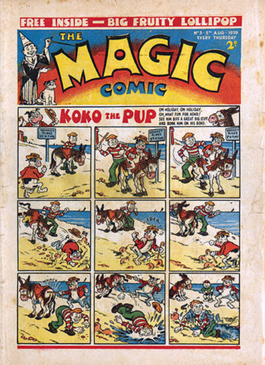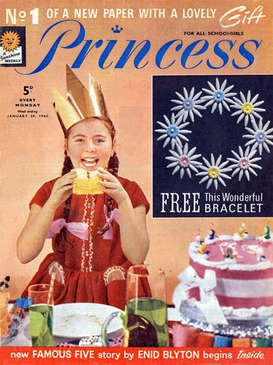Related Research Articles

The Beano is a British anthology comic magazine created by Scottish publishing company DC Thomson. Its first issue was published on 30 July 1938, and it published its 4000th issue in August 2019. Popular and well-known comic strips and characters include Dennis the Menace, Minnie the Minx, The Bash Street Kids, Roger the Dodger, Billy Whizz, Lord Snooty and His Pals, Ivy the Terrible, General Jumbo, Jonah, and Biffo the Bear.

A comic strip is a sequence of cartoons, arranged in interrelated panels to display brief humor or form a narrative, often serialized, with text in balloons and captions. Traditionally, throughout the 20th and into the 21st century, these have been published in newspapers and magazines, with daily horizontal strips printed in black-and-white in newspapers, while Sunday papers offered longer sequences in special color comics sections. With the advent of the internet, online comic strips began to appear as webcomics.

Patrick Eamon Mills is an English comics writer and editor who, along with John Wagner, revitalised British boys' comics in the 1970s, and has remained a leading light in British comics ever since. He has been called "the godfather of British comics".

Little Plum is a British comedy western comics series about a little Native American, originally created by Leo Baxendale and published in the magazine The Beano.

The Dandy was a Scottish children's comic magazine published by the Dundee based publisher DC Thomson. The first issue was printed in December 1937, making it the world's third-longest running comic, after Il Giornalino and Detective Comics. From August 2007 until October 2010, it was rebranded as Dandy Xtreme.

Tricky Dicky is a British comic strip which debuted in the magazine Topper in December 1976 and was drawn by John Dallas. From 1979 to 1986 he was the cover star of the comic, succeeding Danny's Tranny and preceding Beryl the Peril. The strip survived the merger with the Beezer in 1990 and continued in The combined Beezer and Topper comic til it ended in 1993. The character later reappeared in The Beano.

Bimbo is slang for a conventionally attractive, sexualized naïve woman. The term was originally used in the United States as early as 1919 for an unintelligent or brutish man. As of the early 21st century, the "stereotypical bimbo" appearance became akin to that of a physically attractive woman. It is commonly employed to characterize women who are blonde, have curvaceous physiques, wear excessive makeup, and dress in revealing attire while being associated with "the dumb blonde" stereotype.
Sweeny Toddler was a British comic strip by Leo Baxendale, which originally appeared in the British magazines Shiver and Shake, Whoopee!, Whizzer and Chips and finally Buster between 1973 and 2000. It was a gag-a-day about a little mischievous toddler. The name is a play on Sweeney Todd.
Classics from the Comics was a British comics magazine, published from March 1996 until October 2010. Published monthly, it was D. C. Thomson & Co. Ltd's third all-reprint comic. It replaced The Best of Topper and The Best of Beezer, which had reprinted old strips for some years.
Little Star may refer to:

TV Comic was a British weekly comic book published from 9 November 1951 until 29 June 1984. Featuring stories based on television series running at the time of publication, it was the first British comic to be based around TV programmes and spawned a host of imitators.
Playhour was a British children's comics magazine published by Amalgamated Press/Fleetway/IPC between 16 October 1954 and 15 August 1987, a run of approximately 1,700 weekly issues. Playhour contained a mixture of original tales for young children and adaptations of well-known fairy tales.

The Magic Comic was a British comics magazine. It was the ill-fated third comics magazine from DC Thomson. It was aimed at a younger audience, with more emphasis on picture stories. The first issue was published on 22 July 1939. The comic ran for only 80 issues until 25 January 1941. Paper rationing resulting from the outbreak of the Second World War caused its demise. Its Editor Bill Powrie promised that 'the Magic' would return; however, he was killed in action in 1942.

Magazine Enterprises was an American comic book company lasting from 1943 to 1958, which published primarily Western, humor, crime, adventure, and children's comics, with virtually no superheroes. It was founded by Vin Sullivan, an editor at Columbia Comics and before that the editor at National Allied Publications, the future DC Comics.
This is a timeline of significant events in comics in the 1920s.

John Stanley was an American cartoonist and comic book writer, best known for writing Little Lulu comic book stories from 1945 to 1959. While mostly known for scripting, Stanley also drew many of his stories, including the earliest issues of Little Lulu and its Tubby spinoff series. His specialty was humorous stories, both with licensed characters and those of his own creation. His writing style has been described as employing "colorful, S. J. Perelman-ish language and a decidedly bizarre, macabre wit ", with storylines that "were cohesive and tightly constructed, with nary a loose thread in the plot". He has been compared to Carl Barks, and cartoonist Fred Hembeck has dubbed him "the most consistently funny cartoonist to work in the comic book medium". Captain Marvel co-creator C. C. Beck remarked, "The only comic books I ever read and enjoyed were Little Lulu and Donald Duck".
Baby Crockett was one of the longest running comic strips that ran from The Beezer issue 34 to Beezer 1809. He continued in the merged Beezer and Topper until its demise in 1993, and would appear in all the Beezer annuals and summer specials until they ended in 2002. He also appeared in several of the Dandy Comic Libraries over the years.
Celebrity comics are comics based on the fame and popularity of a celebrity. They are a byproduct of merchandising around a certain media star or franchise and have existed since the mass media and comics came into existence in the 19th century. Celebrity comics are usually not held in high esteem by critics, because of their purely commercial nature. They are solely created to capitalize on media trends and therefore published so quickly and cheaply that drawings and narratives tend to be of very low quality.

Princess was a British weekly girls' comic anthology published by Fleetway Publications and, later, IPC Magazines. The first version was published between 30 January 1960 and 16 September 1967, and featured a mix of comic strips, text stories and a large proportion of features; it was merged with Tina to form a new title - Princess Tina - after 399 issues.
Charlie Chaplin comics have been published in the United States, the United Kingdom, and Europe. Charlie Chaplin comic strips first appeared in 1915 in the U.S. and the U.K., cashing in on the tremendous popularity of the comedian at the time; they were some of the earliest comics inspired by the popularity of a celebrity. Although Charlie Chaplin comic strips didn't enjoy enduring popularity in the U.S., a Chaplin comic strip was published in the U.K. from 1915 until the late 1940s, while in France there were Chaplin comics published for more than 50 years.